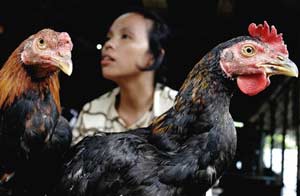In May 2006, an average of one person died every 2.5 days from avian influenza in Indonesia. To date, at least 36 individuals in the country have succumbed to the virus.
The total number of deaths worldwide from this disease has reached 127 since the outbreak began in 2003.
 |
(Photo: cbsnews) |
On June 2, the Director of the Center for Avian Influenza Control under the Indonesian Ministry of Health, Runizar Rusin, reported test results indicating that a 7-year-old girl and a 15-year-old boy from Indonesia died this week due to avian influenza.
According to Mr. Rusin, the girl’s name is Yohana, and she lived in the Pamulang area, southwest of Jakarta. She passed away on the evening of June 1 after receiving treatment in a hospital in the capital, while the boy died on May 30 in Bandung, the capital of West Java Province. Both tested positive for avian influenza. Samples from these two cases have been sent to a World Health Organization (WHO) laboratory for confirmation.
Current concerns are focused on a case involving six members of a family in a village on Sumatra Island who all died from avian influenza. Experts have been unable to identify any source of infection linking these family members to poultry, raising suspicions of human-to-human transmission.
However, no one outside the immediate family has contracted the disease, leading experts to believe that the virus has not mutated. They hypothesize that some individuals may possess genetic traits that make them more susceptible to avian influenza viruses.
Experts suggest that the best way to control the avian influenza outbreak in Indonesia is to focus on poultry populations. However, this approach has not been thoroughly implemented.
Many local governments still refuse to cull infected poultry in affected areas, and vaccination efforts have not been adequately carried out. In contrast, measures taken in countries previously plagued by avian influenza, such as Vietnam and Thailand, have effectively controlled the outbreak.
Both countries have received strong directives from their governments, which have taken the lead in outbreak suppression.
According to the WHO, the actual number of H5N1 cases in Africa, China, and Indonesia may be significantly higher than reported figures. This is due to the low compensation rates for farmers whose poultry are culled, leading them to continue clandestinely raising birds that may be infected.
The WHO advises that a current solution is for wealthy countries to support funding for poorer nations in their compensation programs for culled poultry, while also enhancing warning information about the dangers of H5N1 for farmers.




















































